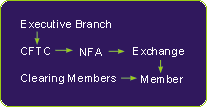Futures Exchange
Learn about futures exchange.
Futures contracts are traded at a futures exchange and only at a futures exchange. Chicago Mercantile Exchange (CME), like the other exchanges in the U.S., provides a place to trade, formulates rules for trading and supervises trading practices. There are currently eight futures exchanges in the U.S.
Chicago, the home of the futures industry, has remained the industry leader because its exchanges have continued to offer innovative solutions to the emerging needs of business for risk management tools. This innovation has not only taken the form of new products (such as the origination and enormous growth of financial futures) but also of new trading technologies. For example, beginning in 1992, CME began offering extended overnight trading sessions for currency futures via its electronic order entry and trade matching system, GLOBEX®. Since then, this system has grown and expanded in use and capability. Now, most of the major contracts traded in the pits at CME (except for agricultural commodities, which will soon be added to the list) can also be traded on GLOBEX when the pits are closed.
In addition, a number of new products designed specifically for electronic trading – as opposed to pit trading – have been introduced. these include the highly successful E-mini S&P 500 contract (the “E” stands for “electronic” and the “mini” refers to the fact that this electronic contract is smaller than its pit-traded regular counterpart, the S&P 500 contract) and the E-mini Nasdaq 100 contract.
Clearing Function
One of the most important functions of a futures exchange is to provide a clearing operation. At CME, this operation is called the Clearing House. The Clearing House is responsible for clearing trades and for the day-to-day settlement. What does that mean? Well, the Clearing House records all the trades happening in the trading pits each day. At the end of the trading session, it matches or reconciles contracts bought and sold.
The Clearing House also settles the traders’ accounts to the market each day. When you buy or sell a futures contract, the exchange requires you to put up a performance bond. That’s a cash deposit to cover any loss your investment may incur. Money is added to your performance bond balance if your position earned a profit that day. However, if your position lost money that day, money is subtracted from the balance. And you may get a call to put more money into the account. The Clearing House figures that out.
Is trading at the exchanges regulated?
Yes, the federal government and the exchange both play a role in regulating trading. Federal law started regulating futures trading in 1923. The Trade Commission Act of 1974 created the Commodity Futures Trading Commission (CFTC), an independent federal body that oversees all futures trading. The National Futures Association (NFA) was created to regulate the activities of brokerage houses and their agents. These measures guarantee the integrity of the markets.

Additional Lessons
- Futures Exchange
- Contracts Traded
- Supply and Demand
- Fundamental Analysis
- Technical Analysis
- Orders in the Pit
- Trading Pit
- Risk Management
- Hedgers & Speculators
- Options on Futures
- Reading Quotes
- GLOBEX
- Hand Signals
- Expiration Months
- Futures Contract
Contents Courtesy of CME Group.